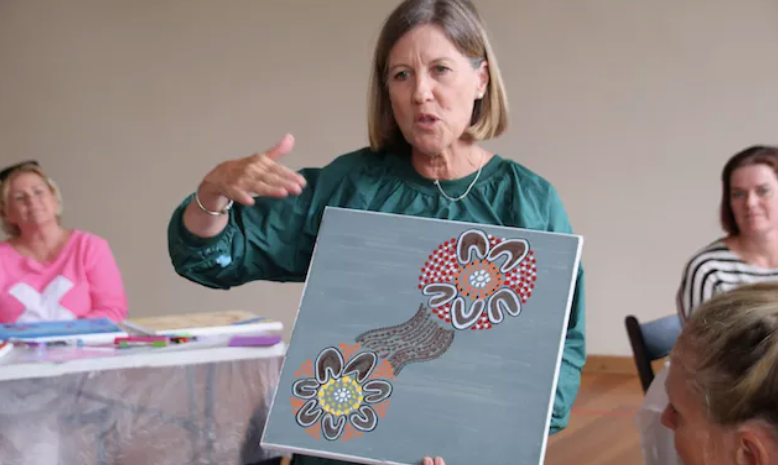We spoke with Simone Reilly, Head of Malvern Campus at Caulfield Grammar School, about her recent Aboriginal Art Workshop.

Why did you choose to run the Aboriginal Art program at the school and what was the purpose of the experience?
The purpose was to commence the start of our school year as a staff with a shared experience that would benefit both the staff’s sense of community and student learning.
It was important that the experience wasn’t tokenistic or a ‘flash in the pan’ but instead an experience we could reference continually throughout the year.
We chose to run the Aboriginal Art program for two reasons: firstly, I wanted to focus on and celebrate the culture of storytelling. Looking through the lens of our Indigenous cultures was the perfect partnership.
Secondly, I wanted to use a mode of expression that many of us, other than our Visual Art teacher, were less comfortable or familiar with.
In previous years, we have participated in some team building experiences which were more physical in nature so it was important for me to reflect our expectations of the classroom and ensure that we experienced feeling out of our comfort zone and expressing ourselves in ways which wouldn’t necessarily be our preferred.
In saying that though, the stories and art work shared at the end by staff were so moving and beautiful that I think we may have ignited a new passion in a few staff!
How do you think the program addresses inclusivity?
I think the program addressed inclusivity from the very beginning. The respectful conversations we had with Sam in the office which helped us frame our thinking around purpose which set us up well for the workshop.
Will was able to introduce the workshop that helped our staff feel connected to the objective while living within our school values.
And then Sandon guiding us through his outstanding art, the broader meaning and history of his piece and how it links to his story and his background.
Once we were creating our own stories through art, there was a great sense of inclusivity, comfort and optimism in the room. The whole program felt like a perfect blend of creativity, reflection, introspection and fun!

How important is storytelling for young people and staff members?
Storytelling is at the heart of education and society in general. Understanding the ‘why’ behind everything we are teaching or learning, providing context and connecting to real world examples is essential if we want our students to be invested in and connect to, their own learning.
I love all forms of stories; the stories behind song lyrics; the back stories of people; the stories behind art; you just feel so much more connected once you understand where an idea came from.
Aboriginal Art is available for students or staff as a 90-min workshop designed to encourage people to explore their own story, through the introductory themes of modern Indigenous art.
Creative team building activities offer a unique and effective way to strengthen bonds among team members while unlocking their creative potential. Here’s a closer look at the importance of incorporating creative team building activities into your workplace culture.
1. Enhanced Communication: Engaging in creative team building activities breaks down communication barriers. These activities often require participants to step out of their comfort zones and communicate in new and unexpected ways. This translates directly to the workplace, improving day-to-day interactions and facilitating more open and effective communication.
2. Strengthened Team Cohesion: Team building activities, especially those of a creative nature, encourage a sense of unity and collaboration. When team members collaborate on a creative project, they learn to appreciate each other’s strengths, leading to a stronger, more cohesive team that can tackle challenges together.
3. Boosted Creativity and Innovation: Creative team building activities provide a platform for employees to explore their creative sides. This not only boosts individual creativity but also contributes to a culture of innovation within the team. As team members become more comfortable expressing and sharing their ideas, the organization as a whole becomes more dynamic and adaptable.
4. Stress Reduction and Morale Boost: Team building activities are known to alleviate workplace stress and boost morale. Creative activities provide a break from routine, allowing team members to relax and enjoy each other’s company. This positive impact can extend into the workplace, fostering a more positive and productive work environment.
5. Problem-Solving Skills: Many creative team building activities involve solving challenges or puzzles. These experiences translate directly to the workplace, enhancing the team’s problem-solving skills. By working together to overcome obstacles in a fun and creative setting, team members develop a mindset that values collaboration in addressing challenges.

